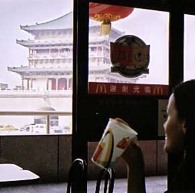China’s Environmental Woes
Travel Blog • Jim Benning • 07.18.06 | 5:27 PM ET
 Photo by Jim Benning.
Photo by Jim Benning.Several years ago I visited China, and I enjoyed just about every minute of it. This photo I shot at a McDonald’s in Xian—Chinese food is great, but a guy needs a break now and again—captures a hint of the juxtaposition between old and new that is becoming such a common sight in the country. But the gorgeous, centuries-old building out the McDonald’s window here looks so gray because in Xian I encountered thick, gray-brown, throat-burning, eye-stinging air, the worst I’d ever seen. It was so bad I bought a cloth cover to wear over my nose and mouth, as many locals do, hoping to filter out some of the pollution. It’s ugly. The World Bank reports that China is home to 16 of the world’s 20 most polluted cities. This week, the public radio show The World is airing a four-part series on China’s environmental problems, entitled “Paying for Prosperity.” The first report, broadcast yesterday, focused on air quality, among other issues. Listening to it, I almost felt like coughing as I recalled Xian and the kind of air that so many people in China have to breathe daily.
Here’s a troubling excerpt:
Linfen is one of Shanxi’s most polluted cities. Residents here say they literally choke on coal dust in the evenings. That’s when trucks piled high with illegally mined coal roar past. In a neighborhood medical clinic, nurse Du Qiufang says the pollution is taking a serious toll on people’s health, including her own:
In Chinese, followed by translation: “I feel like my throat is very dry, and the stuff coming out of my lungs is black.”
And in her clinic, Du says, she’s seeing ever more cases of bronchitis, pneumonia, and lung cancer. Her own father-in-law has lung cancer, she says. So does the father of another health worker here. Du says the central government has tried to improve air quality and has even closed a few of the worst-polluting factories. But the problem, as with so many environmental problems in China, is resistance from local business interests and local government officials.
In Chinese, followed by translation: “Shanxi is a province of coal, and this is the main economic income for the province. There are a lot of coal mines, iron factories and tar refineries. So it’s really difficult to improve the situation in a short time.”